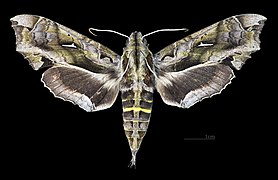Hemeroplanes triptolemus
| Hemeroplanes triptolemus | |
|---|---|

| |
| Hemeroplanes triptolemus Male dorsal | |

| |
| Hemeroplanes triptolemus Male ventral | |
| Scientific classification | |
| Kingdom: | Animalia |
| Phylum: | Arthropoda |
| Class: | Insecta |
| Order: | Lepidoptera |
| Family: | Sphingidae |
| Genus: | Hemeroplanes |
| Species: | H. triptolemus
|
| Binomial name | |
| Hemeroplanes triptolemus | |
| Synonyms | |
| |
Hemeroplanes triptolemus is a moth of the family Sphingidae.
Description[]

Female dorsal
(coll.MHNT)
Female ventral
(coll.MHNT)
Biology[]
Its chest and wings are covered in scales. The moth uses a proboscis to feed itself nectar. Both males and females have a relatively long lifetime of 10 to 30 days. The female moths lay pellucid green eggs. Egg growth varies strongly from 3 to 21 days. There are at least two generations per year with peak flights from January to February and again from June to July.
The larvae feed on . In its larval form, the Hemeroplanes triptolemus is capable of expanding its anterior body segments to give it the appearance of a snake, complete with eye patches. This snake mimicry extends even to the point where it will harmlessly strike at potential predators.[2][citation needed]
Distribution[]
The moth is known from Costa Rica, Belize, Mexico, Guatemala and probably flies throughout Central America into Colombia, Ecuador, Bolivia, Argentina, Venezuela and Guyana.
References[]
- ^ "CATE Creating a Taxonomic eScience - Sphingidae". Cate-sphingidae.org. Archived from the original on 2012-11-10. Retrieved 2011-10-19.
- ^ "Silkmoths". Silkmoths.bizland.com. Archived from the original on 2015-03-25. Retrieved 2011-10-19.
- Dilophonotini
- Moths described in 1779
- Taxa named by Pieter Cramer
- Dilophonotini stubs


